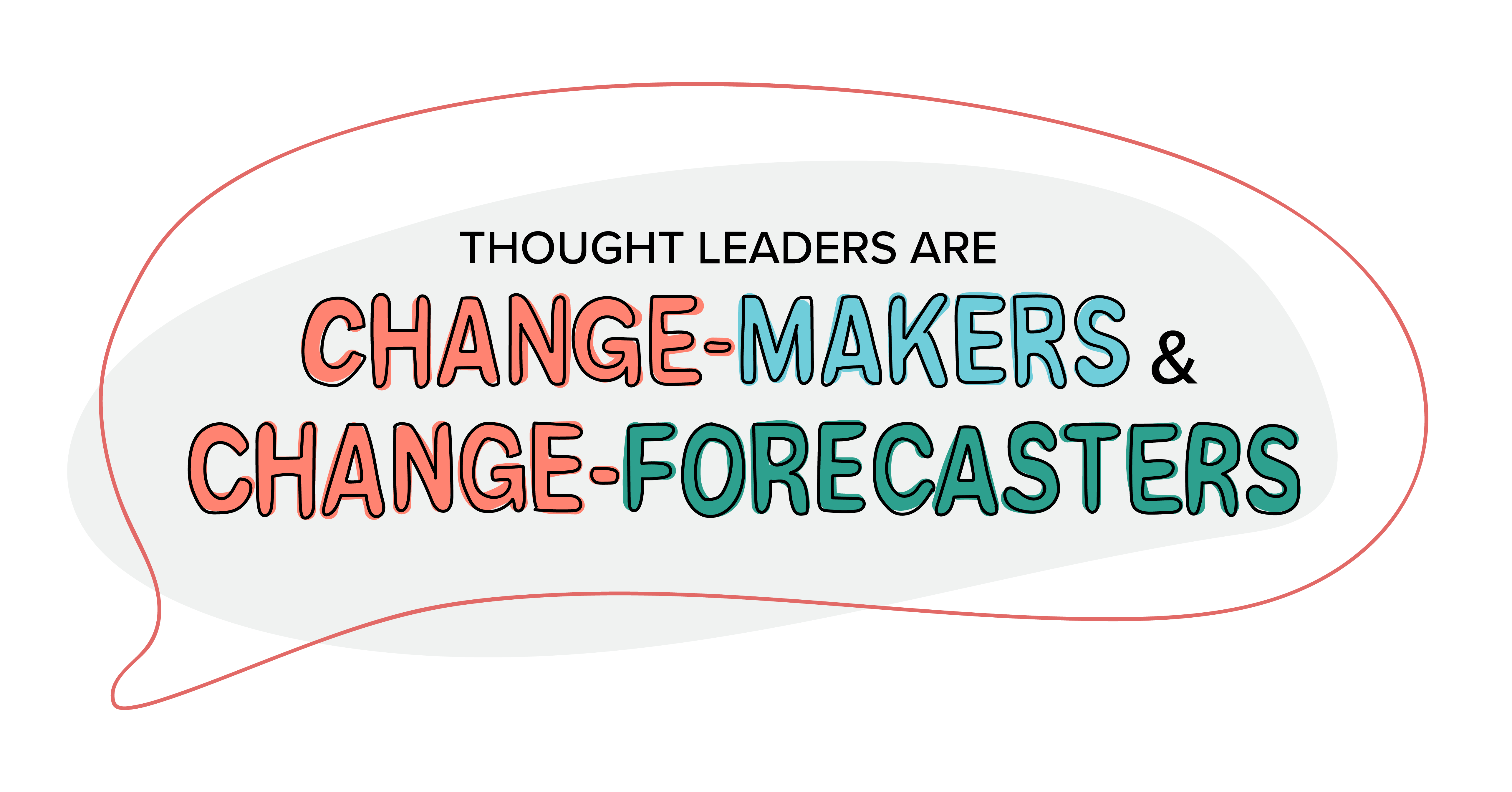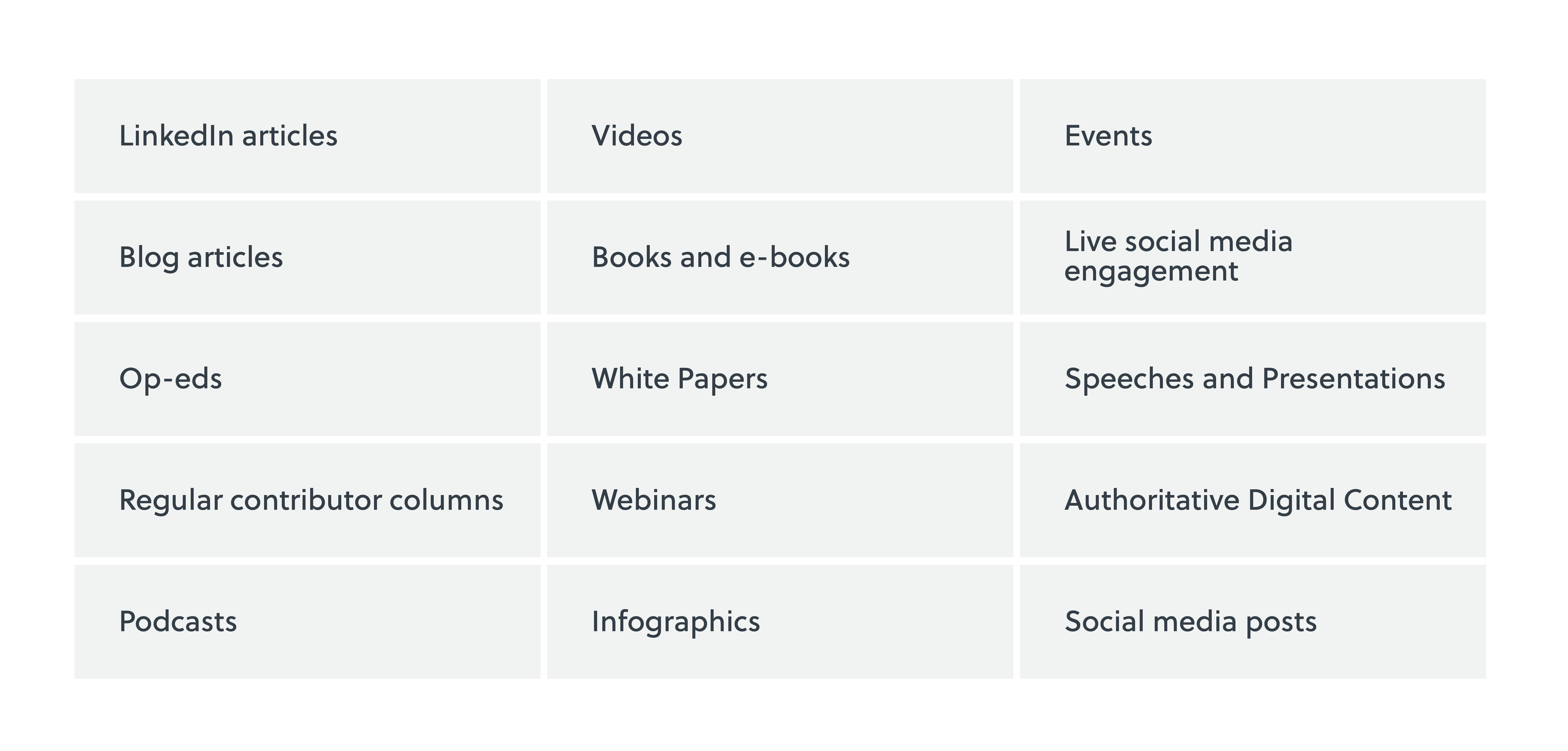
What is Thought Leadership?
David Fouse: Partner, Lead Strategist
Thought leaders are authorities in an industry, or field guiding public thinking on a specific topic or issue. Typically, thought leaders offer a unique, authentic perspective that is connected to their experience or brand.
Thought leadership goes beyond observations of current events. A thought leader analyzes and predicts how those events will impact the way we think and act – and inspires others to think differently. To put it simply, thought leaders are change-makers and change-forecasters.

Executives in this age of high visibility are often expected to be the voice of their brand. Consumers want to know the person behind the product or service they’re using. Thought leadership is one way for executives to increase brand awareness and loyalty, which translates into sales and engagement.
Explore this list to see CEOs who have more followings than the companies they run.

More than ever, executives feel compelled – or are expected – to share their thoughts and opinions on issues that transcend a product or service. It’s a tricky position to master – especially given the threat of immediate and viral customer feedback – and many executives are reluctant to embrace the risk. But there are great brand and customer engagement benefits for purposeful companies and executives that know how to stay focused and leverage their “voice” to advance strategic narratives.
But thought leadership isn’t about knowing everything. In fact, I would advise executives to focus. Because a customer’s mind space is limited and competition for that space is fierce, too broad a topic can water down your authority. So, narrowing your scope is important.
Thought leadership is about sharing a unique, authentic, and value-providing perspective on a topic: Where is the world (as related to your topic) going? What does it mean for your interested audience? What does a customer, an investor, a politician, a patient, etc., need to know about a particular topic in context to what’s happening around them?

Did you know? In 1945, Fortune magazine named Betty Crocker the second most popular woman in America (behind Eleanor Roosevelt). What the public didn’t know was that Betty Crocker wasn’t a real person. She was made up by an advertising company.
For example, Pinkston worked with a medical foundation to establish thought leadership around spine and bone health. We helped create a type of online content (which we call Authoritative Digital Content™) about the link between vaping and back pain. This was a niche topic, but one that research showed was of growing interest among readers and that had not been addressed by other organizations. Within weeks of rolling out our content, the company was rewarded with a #1 position for the topic “back pain and vaping.”
In another example, we worked with a nonprofit organization to create content on veteran suicide. Their article appeared in search results second only to the VA (Veterans Affairs).
So, How Do You Become a Thought Leader?
Have something relevant to say. Your insights should add value to the conversation, and the topic should be connected to you and something you have a reason to care about and share your perspective on – because authenticity is paramount.
Don’t try to sell. In a business context, sales should be considered, of course, but as a down-the-funnel byproduct. Thought leadership is really about relationship building – genuinely providing knowledge and insight that will benefit an audience. One mistake executives sometimes make is relying on their marketing departments to help them build or expand their thought leadership platform. While you can use the data and customer insights marketing departments gather, thought leadership isn’t properly the domain of marketers. Getting this wrong can actually do more harm than good with customers.
Take an omnichannel media approach. This may start with a single tactic like an op-ed or an earned media interview, but strong thought leadership programs rarely end there. Key messages should be consistently shared across all relevant platforms and done so in a way that takes into consideration the next step for the viewer/listener/reader.
Leaders often look to outside partners who specialize in thought leadership strategy to help build these programs. An outside partner can be a great resource to help determine the thought leadership voice that fits your brand, and how to best execute a strategy around it.
A good outside partner can also serve as a facilitator between disparate departments. Given the siloed nature of many corporate communication and marketing teams, this may be the best way an executive thought leadership program can get started and co-exist with other marketing initiatives.

A lack of tactical integration and collaboration is one of the job challenges that lead CMOs to have the highest turnover in the C-suite – between 35 to 41 months on average.
Is your gatekeeper a thought leadership obstacle?
Gatekeepers often try to protect a CEO's time by blocking the meetings or conversations where a skilled messaging team can discover what makes the executive's perspective unique and personal. What results is content that sounds clinical and detached.
For example, op-eds that discuss firsthand experiences do better. But well-meaning teams sometimes try to “protect” a CEO and their time by asking outside communications teams to create content without actually speaking with the CEO. What results is often generic, flat content that doesn’t perform well.
What are the Types of Thought Leadership?
Thought leadership is more than dealing in facts. It’s about storytelling. While the average person consumes more than 100,000 words each day, 92% of consumers say they would prefer to get those words in the form of a story.
Storytelling can be done in an article, a book, a white paper, a video, or even a photograph. It can be a physical or digital manifestation; all tools and platforms are on the table. Keep in mind that the tone should never be didactic. Instead, aim for thought leadership that engages, inspires, and nurtures conversations.
As you begin to lay out a thought leadership strategy, understand where thought leadership lives in the customer engagement flow (hint: it’s at the top and closely tied to brand), and identify what you want to achieve. Do you want more website hits? If so, to what end? Do you want more email signups? Thought leadership is a great way to move people there, but your email program should have a strategy of its own. Do you want to improve your brand’s reputation? Do you want to attract more speaking engagements? These answers will determine who your audience should be for your thought leadership, and, in turn, what types of content you should focus on creating.
What tangible results do you want to achieve?
Website hits
Email signups
Improved brand reputation
More brand partners
Speaking engagements
A book deal
Types of Thought Leadership Content

Whatever type of content you create, be bold: If you’re targeting other executives, know that two-thirds of C-suite audiences prefer thought leadership that provides bold, provocative or contrarian points of view. But keep in mind that customers expect that point of view to be well-founded and ultimately accurate.
Thought Leadership Topics
What should thought leaders talk about? What types of content do audiences want to engage with? Here are seven ideas:
Personal stories: Use a personal experience to relate a lesson or insight that is relevant to your industry and audience. Pinkston research found, for example, that most op-eds in top-tier publications use the first-person voice.
Behind-the-scenes: Take your audience behind the scenes of your daily life, your company, the books you read, the way you schedule your time, etc. This will make you more relatable and give your audience something tangible to remember.
Myths vs. Facts: Dispel common myths about your inedustry or a specific topic within your expertise. The goal of this is to change or challenge your audience’s perception of an idea.
Best practices or explainers on a complex topic: Put something complicated into general terminology. For example, if you are an expert in cryptocurrency, you could create a video or graphic illustrating how cryptocurrency differs from traditional currency.
Original research: Commission a survey relevant to your topic and share the results via a white paper, social media graphics, or a book.
Comment on “news-of-the-day”: Avoid summarizing or simply resharing a news article. Instead, offer a solution to a problem, give an unexpected take on a current issue, or issue a call to action.
Promote your partners (existing or ideal): If you find a particular organization’s products or services useful, share this with your following. Honor partners you have worked with by (honestly) highlighting what they do.

Did you know? LinkedIn members spend almost 3x more time watching videos than static content. Interactive content is key.
Always keep your audience’s attention span in mind. This will vary by platform – but, unfortunately, attention spans are generally shrinking. For example, BuzzSumo analyzed 100 million articles and determined that the ideal headline length has decreased to 11 words or 65 characters, according to the most shared headlines on both Facebook & Twitter.
A word of caution: This is not a referendum for short content. There’s value in brevity, but engagement is the key, and this is platform-dependent. Authoritative Digital Content is a great example of that. Search engine algorithms tend to favor longer articles (1,000-2,000 words) that comprehensively and authoritatively cover a specific topic.
Books and thought leadership
If you have a lot to say on one topic, consider writing a book. Many executives have strong ideas and interesting stories to tell. But for thought-leading CEOs, the goal doesn't need to be royalties or a People magazine spread, but rather, specific business- or brand-related goals.
Books allow executives to communicate their ideas in their own voice, rather than sound bites filtered by the media. As the public becomes more interested in CEOs as real people, developing this voice becomes more important. For example, Bob Iger's 2019 book, The Ride of a Lifetime, helped the former Disney CEO complete his transformation from "underrated CEO to Hollywood royalty," as the Los Angeles Times called him.
Books are also an important way to communicate values or initiate a culture shift. Whole Foods CEO John Mackey, for example, launched a new movement in corporate social responsibility with Conscious Capitalism, written with Raj Sisodia. Former Zappos CEO Tony Hsieh's Delivering Happiness shined a spotlight on good corporate culture practices.
The Benefits of Thought Leadership
Increased business: 48% of C-suite executives said thought leadership directly led them to give business to a company. People are more willing to pay a premium to an organization whose leaders have a clear vision.
More employee engagement: According to Gallup, up to 70% of variance in an employee's engagement depends on their leader. Thought leaders improve employee engagement by fostering a culture of collaboration and by showing employees that they’re actively engaging in the industry.
Increased advertising revenue: Audiences seeking to learn or who are looking for advice are 1.7x more likely to be receptive to advertising.
Increased brand loyalty: When a customer associates a brand with a trusted thought leader or influencer, they are more likely to purchase products that the thought leader recommends – this includes the thought leader’s own brand.
Expanded opportunities: Thought leaders who build a solid base audience with regular content may be offered newer and bigger opportunities over time, like book contracts, speaking engagements, or TED talks.

Tip: Use a “content pillar” strategy. Repurpose one piece of long-form content into multiple pieces of micro-content. For example, a podcast interview can also become a LinkedIn article, an infographic, and a post on X.
Digital Thought Leadership: The New Frontier
As we look to the future, digital thought leadership is paramount. Online authority is more important than ever as hungry AI models search for content to consume.
Web search will have to adapt, and authentic, comprehensive, owned content will become more important than ever. This is evidenced by recent deals struck between content publishers like News Corp and AI platforms like ChatCPT. This May 2024 $250 million dollar deal gives OpenAI access to reporter content as a way to train its model on the strongest, most trusted content.
At Pinkston we think about this as Authoritative Digital Content, and it's something we've invested heavily in for our clients. As thought leadership evolves, the authorities will be the ones who create comprehensive, helpful and consistent content. These authorities will build a relationship of trust with their audience.
Every piece of content is a small piece of the pie that can make a big impact over time. Start small. But think big.
